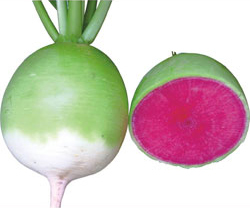Raphanus sativus L. (Brassicaceae) cv. Man Tahg Hong


| ENG | Asian Radish |
| SK | |
| CZ | Asijské ředkve |
| PL | |
| HU |
Using
Radish may be consumed raw, cooked or preserved. Some genotypes can be stored for use during winter, while others can be preserved with salt and dried. Apart from the roots, the leaves, stems, seed pods and seedlings of several species are eaten, and radishes are also often used in traditional medicines.
| I. | II. | III. | IV. | V. | VI. | VII. | VIII. | IX. | X. | XI. | XII. | |||||||||||||
| Sowing | ||||||||||||||||||||||||
| Planting | ||||||||||||||||||||||||
| Harvest | ||||||||||||||||||||||||
Botanical description and occurrence:
Asian (Chinese) radish cv. ´Man Tang Hong´ has erective phyllome with lyrate and dark-green leaf, oblong shaped root with green color, slight main root, bright red flesh, texture is juicy and eating qualities are excellent. 75-80 days maturity.
Why to have the plant in your garden:
Besides its medicinal and healing properties (Anti-cancer, Anti-bacterial, anti-viral benefits), the high nutritional content including Vitamin A, C, E and B-6, potassium, magnesium, calcium, iron and fiber are some of the reasons why it should be part of the diet
Text:
Dr. Tomáš Kopta, Mendel University in Brno, ČR
Photo:
Dr. Tomáš Kopta, Mendel University in Brno, ČR

